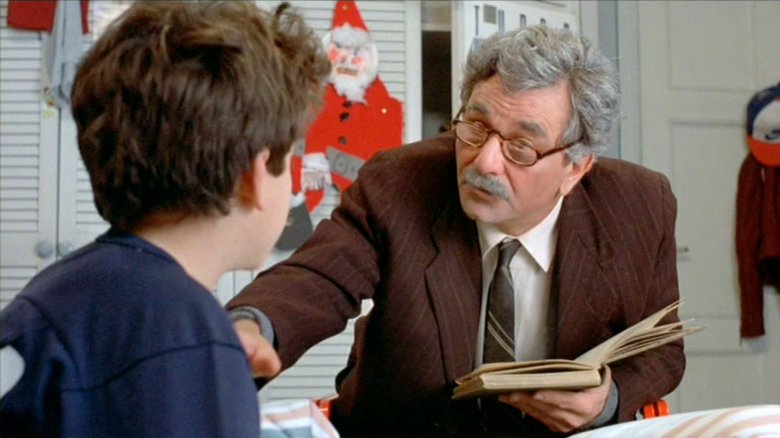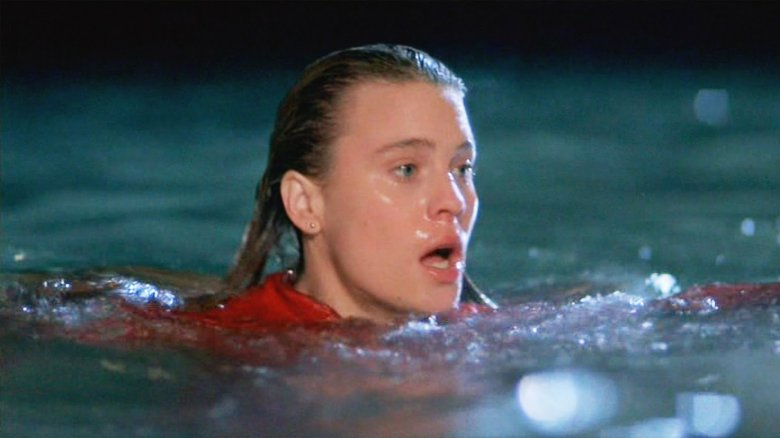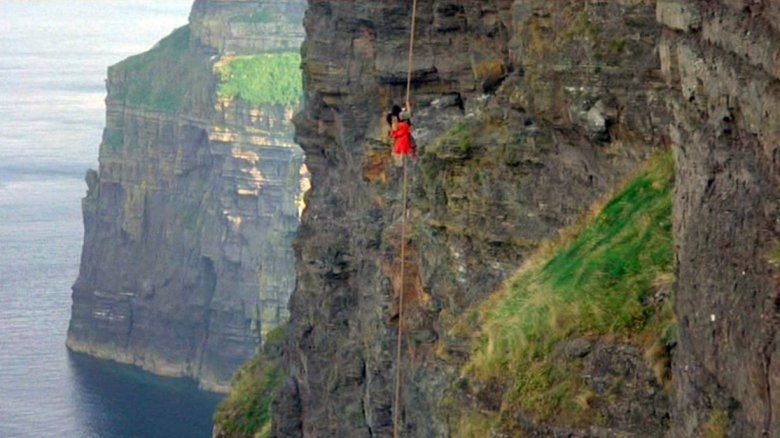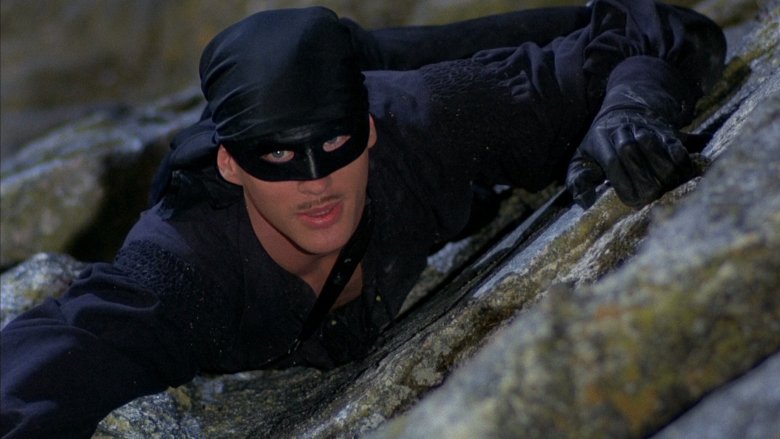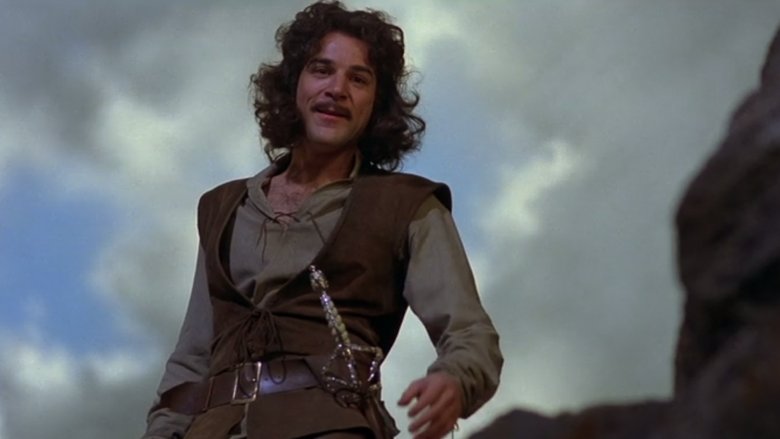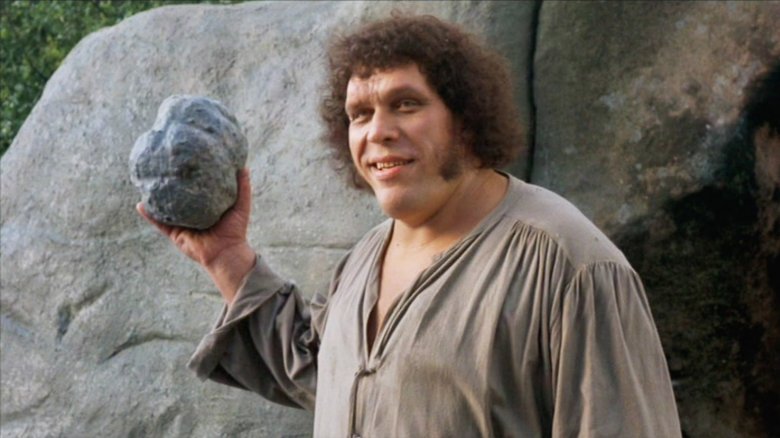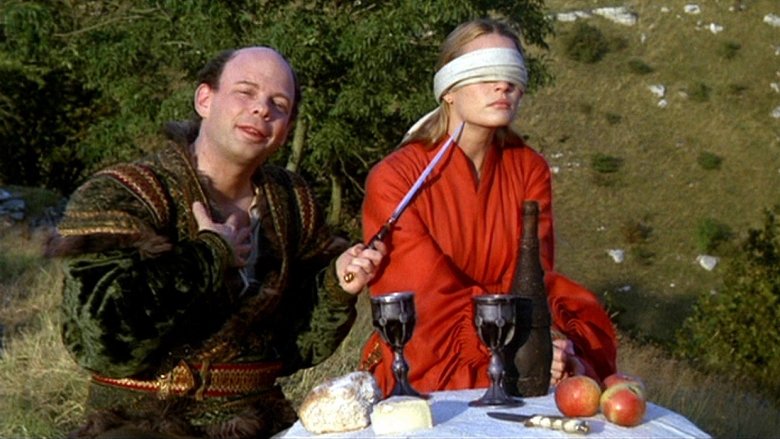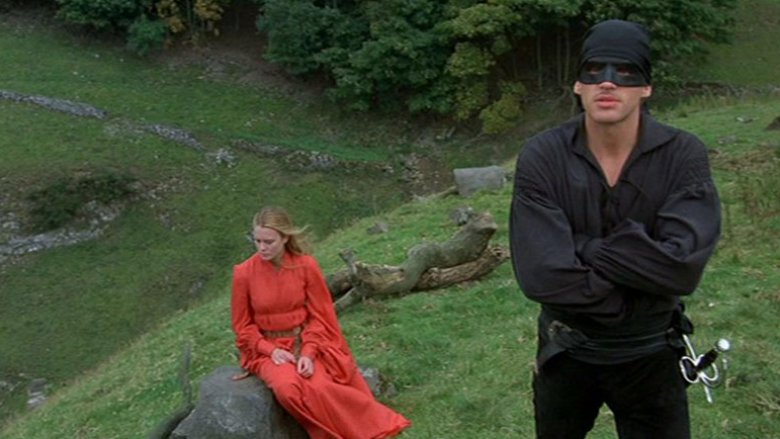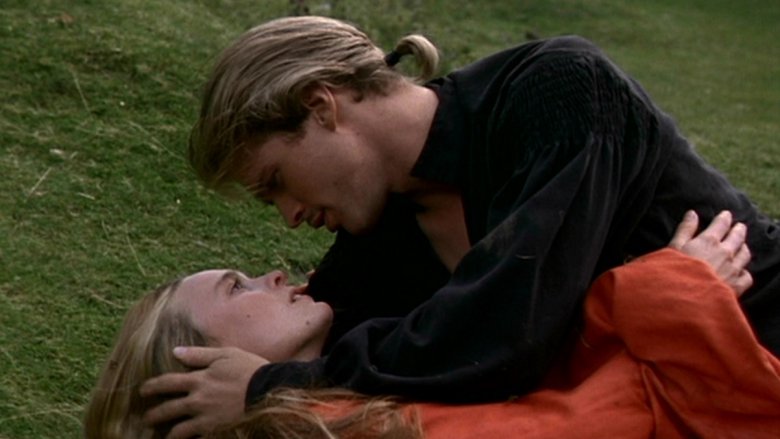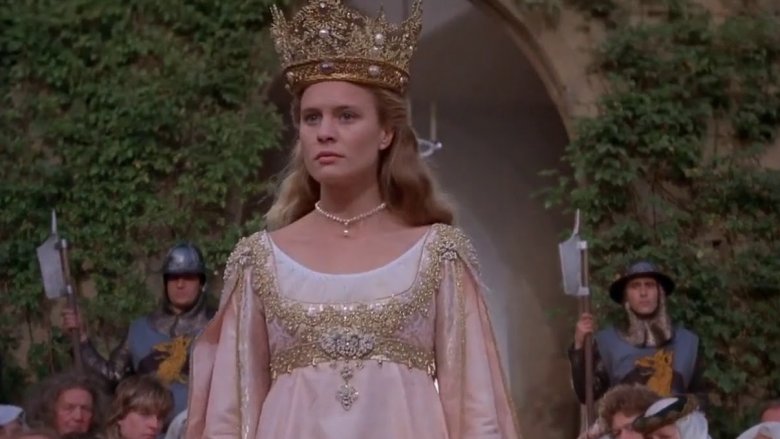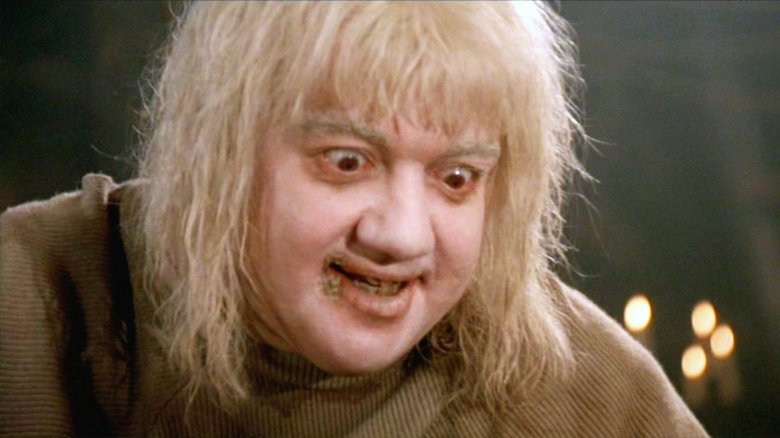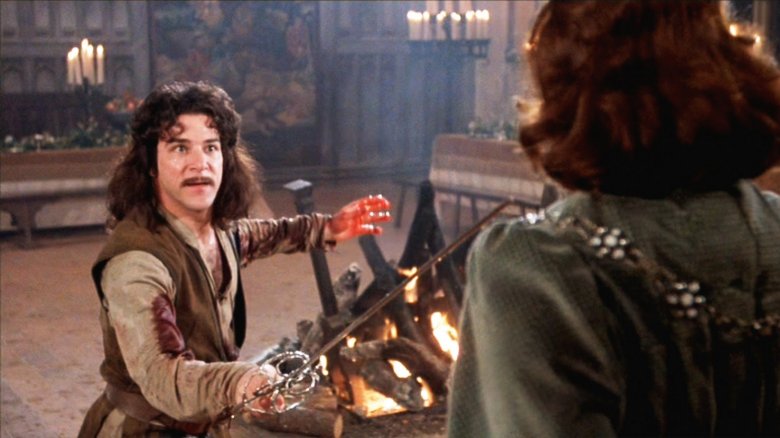Things Only Adults Notice In The Princess Bride
There's a shortage of perfect movies in the world, but one that comes closer than most is Rob Reiner's The Princess Bride. Released in 1987 and faithfully adapted from the novel by William Goldman, The Princess Bride is a timeless tale of fencing, fighting, torture, revenge, giants, monsters, chases, escapes, and true love, and it's often cited as one of the most widely beloved films of all time.
And yet, as close to perfection as The Princess Bride is, it still contains a few elements that, when watching it as an adult, make you tilt your head and go, "Wait, what?" Details, plot points, and lines of dialogue that all congealed into an enchanting whole when you were a kid now jump out and refuse to be ignored. Even if your overall impression of the film is still overwhelmingly positive (as it should be), here are some of the scenes, lines, and circumstances in The Princess Bride you may have missed as a child, but can't help but notice as an adult.
The Princess Bride is technically a Christmas movie
Perhaps you're one of the eagle-eyed few who first noticed this as a child, but most of us gloss right over the fact that The Princess Bride is set during the Christmas season. Santa Claus decorations are scattered around the grandson's (Fred Savage) messy room, most notably the one hanging behind the grandfather (Peter Falk) on the closet door. Additionally, there's a tabletop tree decorated with lights visible through the bedroom door, and when the mother (Betsy Brantley) throws open the grandson's curtains, a snow-covered rooftop lined with lights can be spotted outside the window.
Even The Princess Bride book itself is a Christmas gift. It's given to the grandson wrapped in cheery Santa paper. And if you want to take the Christmas theme a step further, you can even see it carried through in the costumes for the fairy tale sections of the movie, with Buttercup (Robin Wright) and Prince Humperdink (Chris Sarandon) spending much of the movie dressed in rich reds and frosty winter blues and Vizzini (Wallace Shawn) in a festive forest green.
Fezzik has Mr. Fantastic-like superpowers
At first glance, there's nothing amiss about the scene in which Buttercup tries to escape from Vizzini, Fezzik (Andre the Giant) and Inigo Montoya (Mandy Patinkin) by jumping off their ship and attempting to swim to safety. She starts to swim to the unidentified ship in the distance, but stops when she hears the screeches of the shrieking eels, which Vizzini warns her "always grow louder when they're about to feed on human flesh." He offers her the chance to swim back to safety, then Fezzik clunks the eel on the top of its head with a bowling ball-sized fist, and scoops a shaken but unmarred Buttercup up out of the water.
Everything in the scene tracks, until you realize that Buttercup never actually swam back to the boat. She swam away for a few solid strokes, putting her about half a pool-length away from the boat, but then she just fearfully treaded water until Fezzik punched the eel and pulled her back into the ship. Since the boat was never indicated to have changed course, the only way for this scene to have happened is if Fezzik's arms suddenly stretched to a ridiculously long length of probably at least eight feet. He may be a giant, but he's not that much of a giant.
Vizzini's Cliffs of Insanity plan didn't make much sense
Vizzini's plan once his boat reaches the Cliffs of Insanity is simple. Fezzik will carry his party up the sheer face of the cliffs, using the long length of rope dangling down from the top, and then they'll press on into Guilder and murder Buttercup, thus inciting a war. When they arrive at the base of the cliffs, a triumphant Vizzini proclaims that it doesn't matter that the ship behind them has nearly caught up with them. As he explains, "Only Fezzik is strong enough to go up our way," adding that their pursuer will "have to sail around for hours until he finds a harbor."
Except, the fact that the rope is there implies that Vizzini has already been to this location, and tied the rope at the top to prepare for this part of the plan. Presumably, he didn't free solo his way to the top and then shimmy back down. He likely docked in the very harbor he's claiming the other ship can't possibly know about. What's more, the castle ruins at the top seems to imply that at one point, this was a well-traveled destination in Guilder, meaning that the location of the harbor shouldn't be such a mystery. This begs two questions. One, why didn't Vizzini just use the harbor to begin with, since he clearly knew where it was? And two, why would he assume no one else had that knowledge?
Westley's trajectory up the cliffs raises a lot of questions
Everything about the Cliffs of Insanity sequence in The Princess Bride is undeniably thrilling, from the race up the face of the cliffs to Westley's (Cary Elwes) "inconceivable" ability to cling to the rocks instead of plummeting to the ground below. However, when you consider the shots of Westley climbing mere seconds before Vizzini slices the rope, it doesn't make sense that he'd be able to grab onto the rock face in the moment he felt the rope begin to slip. Westley was dangling a good eight feet from the cliff face, meaning he would've had to swing on the rope and jump onto the rocks to have had a chance at winding up in the position we eventually find him in. Even if there was enough time for him to have done this between shots (there wasn't), why would he? He was making much better time on the rope than he does on the rocks.
As an additional layer of mystery, how did Westley's boots become so full of rocks once he reached the top? In every shot we saw of Westley climbing the rope, his legs were kicking freely in the open air, far from the rocks. What was he doing in the few seconds when the camera wasn't on him that would not only enable him to grab on to the rock face but fill his boots with stones? We may never know.
Inigo's sense of honor could've gotten him killed
When Westley eventually reaches the top of the Cliffs of Insanity, Inigo graciously offers him a chance to catch his breath, saying they can wait until he's ready to duel. While this act seems motivated by honor, Inigo may have also had a selfish motive. Shortly before this moment, Inigo tells Vizzini that he will be fighting left-handed in order to make the duel last longer. Allowing Westley time to recover may have been in service of the same goal, with Inigo finding little satisfaction in besting a winded opponent.
However, there's another indication of Inigo's sense of honor in this scene, one which could've proven deadly. In relaying the story of his father's murder, Inigo hands Westley his only weapon without hesitation before their duel. If Westley had less integrity than Inigo, he could've killed him right then and there, while he was unarmed and defenseless. That it didn't seem to even occur to either swordsman to behave less than honorably in this moment speaks loads about the sorts of characters they are, and it's why we root for both of them.
Fezzik's intriguing backstory
As a child, it may have been difficult to make out every line of dialogue during Fezzik's fight with Westley, given that both participants spend most of the scene significantly exerting themselves and occasionally choking. However, if you can catch all of Fezzik's lines, you may be left wanting a lot more information about the hulking Greenlander's life before he came to work for Vizzini.
At first, when Fezzik offers to fight Westley in hand-to-hand combat, he explains that, "I hate for people to die embarrassed," begging the question of just who Fezzik has seen die embarrassed and exactly what his role in their death was. He also tells Westley, when explaining why he has so much trouble fighting a single opponent, that he's more used to groups, specifically "fighting gangs for local charities." His logic that different types of fights rely on different skill sets is sound, but it's hard to simply skate past the fact that Fezzik's past seems to have included significant mercenary work for neighborhood nonprofits. While no one wants a Princess Bride remake, we wouldn't turn up our noses at a prequel exploring precisely which causes these "local charities" in Greenland were championing that required them to have their own one-man brute squad.
Where did Vizzini's picnic come from?
The "Battle of Wits," in which Vizzini talks in circles until finally dying mid-triumphant laugh from a sip of iocane-poisoned wine, is one of the most iconic scenes in a film made up almost entirely of iconic scenes, so it's easy to miss that the picnic laid out in front of Vizzini makes almost no sense. Vizzini wasn't carrying anything when he departed the boat and took the Fezzik elevator up the Cliffs of Insanity, nor did he appear to have any supplies waiting for him at the top.
So where did he get the two goblets, bottle of wine, two apples, block of cheese, hunk of bread, and a cheese knife, not to mention the tablecloth it was all laid out on? Did he just have it all set up on a random rock, ready to go? And if so, why? Was it supposed to be lunch for him and his team? But then, why only the two goblets? Or was Vizzini somehow so clever that he not only foresaw that they would be followed from Florin and pursued up a cliff, but even knew that their pursuer would best his hired muscle and come for Vizzini personally? If so, we suppose he was right after all — we really shouldn't go in against a Sicilian when death is on the line.
Westley's 'Dread Pirate Roberts' act isn't charming at all
Above all else, The Princess Bride is a story of "true love," with Westley and Buttercup representing the ultimate ideal of two people completely swept up in each other. However, although most of the couple's scenes together are indeed swoon-worthy, there's one that sticks out as exactly the opposite. Perhaps Westley is still in character as the Dread Pirate Roberts when he implies that the promises of women are worthless, or that Buttercup is "not capable of love" because she got engaged to another man after her true love was killed. It's not much of an excuse — even considering his pirate persona, he still sounds like he's expressing his actual feelings — but it's something.
Less excusable is when Westley raises his fist to Buttercup, telling her, "That was a warning, highness," before adding that where he comes from, there are "penalties when a woman lies." Pirate or not, this sort of threatened violence is abusive and bad, regardless of whether or not Buttercup had been telling the truth (which, for the record, she was). After this, the movie quickly pivots to reveal Westley's true identity, and from then on, he and Buttercup seem hunky dory, but in a more realistic world, she'd likely never forget that her partner once refused to believe her, said her word was worthless, called her faithless, and threatened to hit her for not liking what she said.
Maybe death should stop true love
"Death cannot stop true love" is an immensely quotable line, but when you think about it, it's not a very reasonable mantra to live by. When Westley asks why Buttercup didn't wait for him, she responds, very practically, that he was dead. Remember, he was gone for five entire years and pronounced dead at some point during that time. Knowing that her chance to marry for love died with Westley, Buttercup instead agreed to an arranged marriage with a prince, which wasn't at all unreasonable for a woman of her station in the medieval-esque setting in which the story takes place.
However, according to Westley, she should've kept right on waiting for him, despite his years-long absence and legally declared death. According to his logic, the only course of action acceptable for a woman who's lost a partner is to remain faithful forever and unmarried for the rest of her life, on the off chance that maybe he's not really dead and may, eventually, come back to life. Put like that, it's a wonder that Buttercup didn't drag him back up that hill just so she could push him down again.
Buttercup deserves more credit in The Princess Bride
Probably one of the most memorable scenes in The Princess Bride is Buttercup's nightmare of being publicly booed for the choices she's made throughout the film, such as her agreement to marry Humperdink if Westley's life is spared. Buttercup is plagued by the fear that she's done the wrong thing. And as a child, it's easy to agree with her, swept up in the romantic notion that she should've dug in her heels and refused to compromise her ideals, holding fast to the notion that true love will conquer all, and that her bond with Westley is enough to overcome any obstacle thrown their way, be it rival suitors, an opposing army, or literal death.
But as an adult, it's easier to see that Buttercup may be unfairly maligned. Throughout the film, Buttercup displays exemplary courage, keeping her cool through multiple abductions, repeatedly refusing to be bulldozed by the powerful Prince Humperdink, and suggesting strategies to resolve conflict that would minimize bloodshed. As a woman from a modest farm, Buttercup wouldn't hold much power, but she uses what leverage she does have to selflessly strike a bargain that she believes will keep Westley safe, at great cost to herself. It's only once she believes she's secured Westley's freedom that she finally unleashes her true opinions at Humperdink, pushing back against his dismissal of her as a "silly girl" by telling him he's "nothing but a coward with a heart full of fear." All hail Queen Buttercup, indeed.
Fezzik probably killed the Albino
When Inigo gets the idea to ask the Man in Black (aka Westley) to help him plan his castle onslaught to find and kill Count Rugen (Christopher Guest), he and Fezzik follow Westley's screams to the grove hiding the entrance to the Pit of Despair. There, they encounter the Albino (Mel Smith), Rugen's minion who maintains the Pit in his absence. Inigo asks the Albino where they can find the Man in Black, but the Albino says nothing, seemingly too intimidated by Fezzik's size and Inigo's sword. Inigo asks Fezzik to "jog his memory," and Fezzik subsequently gives the Albino a heavy blow on the top of the head, causing the Albino to collapse into his wheelbarrow. Fezzik then apologizes, saying he "didn't mean to jog him so hard."
Watching this scene as a kid, it's easy to assume Fezzik merely knocked the Albino out, but watching it as an adult, it becomes clear that the Albino is likely dead. The blow he takes to the head looks extremely forceful, likely causing a catastrophic brain bleed, and his eyes remain open as he keels over, reminiscent of Vizzini's appearance when he died earlier in the film. Even if the Albino didn't die right away, Fezzik and Inigo leave him there without medical attention, making it likely that the severe head trauma he suffered would eventually lead to death.
Inigo probably died after the end of The Princess Bride
After spending the whole film building up to it, Inigo Montoya's final showdown with Count Rugen is nothing short of spectacular, with a chase that spans much of the castle, a moment of devastating doubt when Rugen catches Inigo in the stomach with a thrown dagger, and ultimately, a thrill of tremendous triumph when Inigo rallies and kills Count Rugen, repeatedly shouting the line he's been preparing to deliver since he was 11: "Hello. My name is Inigo Montoya. You killed my father. Prepare to die."
After Count Rugen dies, Inigo heads off to find the rest of his group, and he's offered the position of Dread Pirate Roberts by Westley before the four heroes head off on white horses. But chances are good that Inigo will never live to explore an exciting new career in piracy. He suffered precisely the same wounds as Count Rugen — stab wounds to each shoulder and a deeper one to the gut — which proved fatal in the six-fingered man. Inigo managed to rally and win his duel, but it was likely adrenaline that allowed him to ignore the severity of his wounds and stay on his feet. Once the foursome was out of danger and Inigo's adrenaline wore off, he likely tumbled off his white horse and — since it appeared the group was headed off into the untamed mountains and not to a doctor — died of blood loss. Trust us, we don't like this any more than you do.

